
Last month we proudly announced 10 new arrivals into the Sake Online stable, and hopefully you have had a chance to sample our first highlight, the Junmai Daiginjo, “Soul of the Sensei” from Doi Shuzo in Shizouka.
This month I am going to detail three more from this amazing range of sake.
These three Junmai sake are great examples of the brewers art, remembering, that Junmai is “pure rice’ sake that contains no addition brewers alcohol added during the brewing process.
Nanbu Bijin’s “Southern Beauty Junmai Ginjo” is on the softer side but both “Mukune Root of Innocence Tokubetsu Junmai” and “Mantensei Star-Filled Sky Junmai Ginjo” have great body and richness that well are suited to a variety of food.
Kanpai!
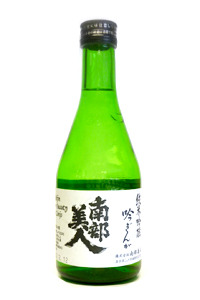 |
Southern Beauty Junmai Ginjo
Nanbu Bijin Nihonshu-do +1 Aroma profile: Lolly water and pear pastille |
♦ Kura History ♦
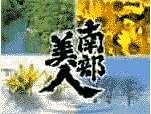 Nanbu Bijin Brewery (formerly known as Kuji Shuzo) is located in northern Japan’s Ninohe City, an area long referred to as “Nanbu no Kuni.” It is an area blessed with lush and beautiful natural reserves, fine water, two national parks, and a lake. We were established in 1902, but at first were only a sake retailer. In 1915 we acquired the necessary licensesand began to brew sake. Our facilities lie on what was once known as the Okumura Kaido, old National Route Number 4. The all-glass front of the main building gives the proper impression of a shop, while the kura (brewery building) behind it is a gorgeous, all-wood, traditional structure. Its ancient, thick pillars and their shining dark color convey the long history of the place.
Nanbu Bijin Brewery (formerly known as Kuji Shuzo) is located in northern Japan’s Ninohe City, an area long referred to as “Nanbu no Kuni.” It is an area blessed with lush and beautiful natural reserves, fine water, two national parks, and a lake. We were established in 1902, but at first were only a sake retailer. In 1915 we acquired the necessary licensesand began to brew sake. Our facilities lie on what was once known as the Okumura Kaido, old National Route Number 4. The all-glass front of the main building gives the proper impression of a shop, while the kura (brewery building) behind it is a gorgeous, all-wood, traditional structure. Its ancient, thick pillars and their shining dark color convey the long history of the place.
♦ The Sake ♦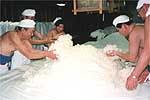
In 1951, we decided to stop making the sweet sake so common back then, a style with plenty of off-flavors. Instead,we decided to brew “clean and beautiful” sake. Hence, we created the Nanbu Bijin brand name to personify our sake. Nanbu stands for the region, and Bijin (meaning beautiful woman) for the delicate, light, and clean nature of our sake. Our sake is brewed with medium-hard water that is purified naturally as it courses through the mountain rock on its way to the sea. We use Hito-mebore, Toyonishiki and Sasanishiki sake rice (see Rice Varieties for more), and of course, our sake is brewed by a Nanbu-area toji.
♦ The People ♦
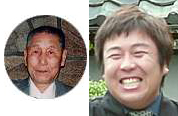 << Photo: Kuramoto Kuji Hideo and Son, Kuji Kosuke
<< Photo: Kuramoto Kuji Hideo and Son, Kuji Kosuke
We employ about 25 people at Nanbu Bijin. We are still very much a family-run organization. About six people are involved in the brewing process, one of them a former sumo wrestler! The future of Nanbu Bijin lies with our present chief of production, young and energetic Kosuke Kuji. Slated to be the 7th generation kuramoto, he has already come to represent the face of Nanbu Bijin. “I want as many people as possible to know of and taste the sake we brew; it is a piece of our history, our culture, and of Iwate Prefecture.”
♦ Size and Special Characteristics ♦
We brew about 1200 koku of Nanbu Bijin each year, which amounts to about 200 kiloliters. This just about suits our size in terms of personnel and equipment. If we became much bigger, we might not be able to control our quality as well as we would like.
♦ Notable Sidelights ♦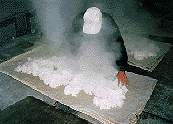
We have a strong web presence (in Japanese language only), with lots of information on sake brewing. Check it outat www.nanbubijin.co.jp. Also, Ninohe City, beyond being blessed with an abundance of natural beauty, is also rich in historical assets and anecdotes. You can learn more than you will ever need to know about Ninohe at
www.w-net.ne.jp/ninohe/ (again only Japanese). Should you travel to Ninohe, you can see the oldest sake vending machine in Japan, a Taisho Era (early 1900s) wooden box that sold free-running sake for 5 sen (half a yen). There was also a spigot for water for rinsing your cup. It is now in the Ninohe City Historical Folk Materials Museum.
♦ Toji (Master Brewer) ♦
 Our toji, Mr. Hajime Yamaguchi, is truly amazing. He has been with us since 1964, more than a quarter of a century. He has won countless awards from the tax department, as well as from the Nanbu toji association. In 1992, he was selected by the Ministry of Labor as one of the 100 Great Craftsmen. While fervently preserving traditions, he actively develops new technology and contributes much to the industry. Yet, he remains humble. “No matter how long I make sake, I am clueless about brewing. In the end, it is a matter of understanding the relationship between the water and the rice, and it is difficult to try and grasp the infinite variations between them.” Sake is born of the experience and efforts of the toji, and their love for the sake they brew. We are proud and privileged to have such a skilled and intuitive toji with us.
Our toji, Mr. Hajime Yamaguchi, is truly amazing. He has been with us since 1964, more than a quarter of a century. He has won countless awards from the tax department, as well as from the Nanbu toji association. In 1992, he was selected by the Ministry of Labor as one of the 100 Great Craftsmen. While fervently preserving traditions, he actively develops new technology and contributes much to the industry. Yet, he remains humble. “No matter how long I make sake, I am clueless about brewing. In the end, it is a matter of understanding the relationship between the water and the rice, and it is difficult to try and grasp the infinite variations between them.” Sake is born of the experience and efforts of the toji, and their love for the sake they brew. We are proud and privileged to have such a skilled and intuitive toji with us.
● ● ● ● ● ● ● ● ● ● ● ● ● ● ● ● ● ● ● ● ● ● ● ● ● ● ● ● ● ● ● ● ● ● ● ● ● ● ● ●
 |
Root of Innocence Tokubetsu Junmai
Daimon Shuzo Nihonshu-do +1 Aroma profile: Clean light nose with slight mustiness |
♦ Kura History ♦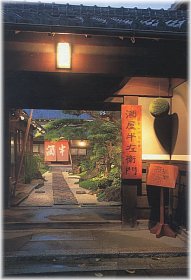
Daimon Shuzo, founded in 1826, is located at the foot of the scenic Ikoma mountain range in Katano City (near Osaka).
Katano occupies a well-known spot in Japanese history. During the Heian era (over 1000 years ago), the aristocracy of Western Japan flocked to Katano to enjoy the very beautiful scenery that abounded there including lovely cherry blossoms in the spring and the verdant surrounding mountains.
Hunting was the main sport of the gentry and cotton seed oil and silk production were the usual industries of the residents.
Sake production began during the Edo period, but of the many sake-producing firms originally present, only Daimon Shuzo and one other remain.
♦ The Sake ♦
“The sake we make is known by the brand name Rikyubai. Our sake is, in general, full flavored but mellow and balanced. Our higher grades of sake are often very lightly laced with fruit essences such as pear and peach. A nice acidity suffuses the flavor, allowing it to spread out evenly.”
♦ The People ♦
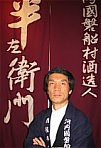 << Photo: Current Director, Yasutaka Daimon
<< Photo: Current Director, Yasutaka Daimon
The current director, Yasutaka Daimon, is the sixth-generation director of Daimon Shuzo. He notes that in Japan there has been a recent trend away from sake and toward other beverages like wine. “We take a great pride in our traditional product and I feel that the distinctive taste and manner of drinking sake is inherently tied to the Japanese culture and spirit. I promise to endeavor to continue to produce our high-quality sake with the hope that future generations of all people can enjoy and savor this fine and relaxing style of drinking sake.”
Daimon also runs a restaurant and bar at the brewery — Mukune Tei. The setting is both rustic and quaint, the food quite good, the prices reasonable. It’s a great treat to drink sake where it is made.
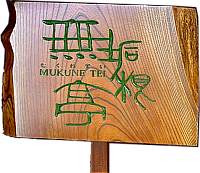
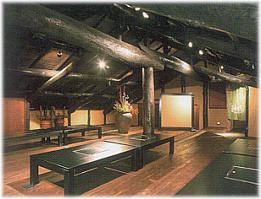
▲Photo (right) Inside Mukune Tei Restaurant located within Daimon Brewery
♦ Size and Special Characteristics ♦
Daimon Shuzo produces about 500 “koku.” As one koku (the traditional measure of sake in Japan) is 180 liters, about 90 kiloliters is brewed here each year, in the traditional brewing season which runs from late October to early April. This is fairly small by industry standards, but allows Daimon Shuzo to strictly control the quality and style of the sake they produce.
♦ Notable Quotes from Master Daimon ♦
“The most important factor involved with producing good sake is the water supply. We have been blessed with a natural spring providing water which is rich in minerals pure enough to be used in the production of excellent sake. Many people have shown an interest in our water alone, preferring to use it when they do the Japanese tea ceremony, or even for healthy consumption at home in regular tea and coffee. We have also been growing our own Yamada Nishiki rice, the king of sake rice, in cooperation with local rice growers, thus keeping us close to the community in yet another way.”
● ● ● ● ● ● ● ● ● ● ● ● ● ● ● ● ● ● ● ● ● ● ● ● ● ● ● ● ● ● ● ● ● ● ● ● ● ● ● ●
 |
Star-Filled Sky Junmai Ginjo
Suwa Shuzo Nihonshu-do +1 Aroma profile: Soft, honey-laced nose with just a tad of fruitiness. |
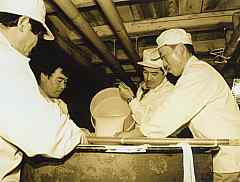 ♦ Kura History ♦
♦ Kura History ♦
Our kura was founded in 1859. The name Suwa Izumi was taken from a local Shinto shrine, Suwa Jinja. The shrine itself has been in existence since 1278, and is a famous local attraction. Tottori Prefecture, where we are located, is one of the least populated regions of Japan, and undoubtedly has some of the most beautiful nature. Mountains, oceans and wooded areas vie for space, with people in the minority. The clean air and the cold winters make it ideal for sake brewing. Located about two hours outside of Osaka by express train, there are only 23 sake breweries still remaining in the prefecture.
♦ The Sake ♦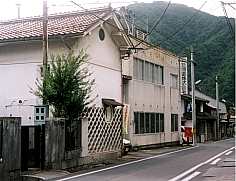
Overall our sake is dry, and wonderfully approachable as a result of the water from which it is brewed. Our water is extremely soft, but it ferments well at low temperatures. So we make our sake with long, low-temperature fermentation, which allows a gentle ginjo fragrance, and a fresh lively flavor to develop. Also, as we know koji is where good sake begins, we do it our own way, which is to make the koji at a slightly higher temperature than usual. This helps give our sake a clean and pleasant finish.
Our sake, in particular our Daiginjo Ottori, has its fans from all over Japan. We have won nine gold awards in the national New Sake Tasting competitions, including five consecutive awards, from 1991 to 1995, and 12 similar awards within Tottori.
♦ The People ♦
 “I want to make sake that continues to be competitive, and that calls for using highly polished rice,” states our former president and now chairman of the board, Michio Nanjo. His enthusiasm and willingness to spare no expense and cut no corners is a big reason why our sake is so popular. He keeps extremely busy not only with keeping tabs on how the sake is coming along, but also working with the Tottori Prefecture Brewer’s Union.
“I want to make sake that continues to be competitive, and that calls for using highly polished rice,” states our former president and now chairman of the board, Michio Nanjo. His enthusiasm and willingness to spare no expense and cut no corners is a big reason why our sake is so popular. He keeps extremely busy not only with keeping tabs on how the sake is coming along, but also working with the Tottori Prefecture Brewer’s Union.
♦ Size and Special Characteristics ♦
Presently we brew about 1400 koku each winter. One koku is equivalent to 180 liters, so we are brewing about 250 kiloliters a year. Indeed, we are quite small, but we can accomplish all of our goals from where we are.
♦ Notable Quotes ♦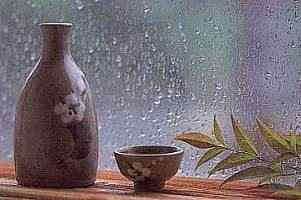
Our water source is a well of very soft water (hardness is about 2.0) on our land. We have plenty of it, so we use the same water for everything: brewing, washing tools, even blending. The well is surrounded by lush nature and pine trees; it needs no filtering nor chemical doctoring at all.
♦ The Toji (Master Brewer) and Kurabito ♦
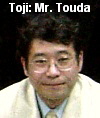 Our current toji is Touda Masahiko. His many years of experience with us continue to allow us to provide consistently flavorful sake to our customers. In 1997, our former toji, Mr. Narikawa Mitsuo, retired from active toji work, but remains on with us as an advisor. He was replaced by Mr. Oka Kentaro, a wonderful Hiroshima toji who died in an unfortunate accident in 2004. Both were highly skilled and creative brewers, helping to make Suwa Izumi what it is today. Mr. Narikawa was the only Hiroshima toji in this region while he was active, as was Mr. Oka. In 1996, Narikawa won an award from the Ministry of Labor as being a “Famous Craftsman of this Generation.”
Our current toji is Touda Masahiko. His many years of experience with us continue to allow us to provide consistently flavorful sake to our customers. In 1997, our former toji, Mr. Narikawa Mitsuo, retired from active toji work, but remains on with us as an advisor. He was replaced by Mr. Oka Kentaro, a wonderful Hiroshima toji who died in an unfortunate accident in 2004. Both were highly skilled and creative brewers, helping to make Suwa Izumi what it is today. Mr. Narikawa was the only Hiroshima toji in this region while he was active, as was Mr. Oka. In 1996, Narikawa won an award from the Ministry of Labor as being a “Famous Craftsman of this Generation.”
………………………………………………………………………………………………………………………………………………………………………
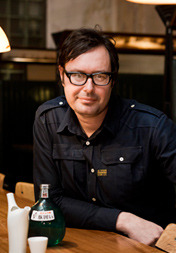 Andre Bishop is a Melbourne based Sake Professional and is recognized as one of Australia’s leading authorities on Sake. His 12 years of experience in designing Asian and specifically Japanese venues include well know Melbourne establishments Robot Bar and Golden Monkey. He currently owns the 22 year old Japanese dining institution Izakaya Chuji and Sake Bar Nihonshu. He is also co-owner and founder of Melbourne’s flagship Izakaya and Sake Bar, Kumo in Brunswick East. Andre studied Sake in Japan and is the only Australian who currently holds a Level 2 Sake Professional Certificate from the International Sake Education Council.
Andre Bishop is a Melbourne based Sake Professional and is recognized as one of Australia’s leading authorities on Sake. His 12 years of experience in designing Asian and specifically Japanese venues include well know Melbourne establishments Robot Bar and Golden Monkey. He currently owns the 22 year old Japanese dining institution Izakaya Chuji and Sake Bar Nihonshu. He is also co-owner and founder of Melbourne’s flagship Izakaya and Sake Bar, Kumo in Brunswick East. Andre studied Sake in Japan and is the only Australian who currently holds a Level 2 Sake Professional Certificate from the International Sake Education Council.
Andre is available for Consulting on Sake, Japanese Beverage Lists, Sake Staff Training and Sake Equipment. Contact: andrebishopsan@gmail.com
Sake Master Andre’s blog: www.sakemaster.com.au
Twitter: sakemasterandre
Sipping with the Sake Master #10
Sipping with the Sake Master #9
Sipping with the Sake Master #8
Sipping with the Sake Master #7
Sipping with the Sake Master #6.2
Sipping with the Sake Master #6.1
Sipping with the Sake Master #5.2
Sipping with the Sake Master #5.1
Sipping with the Sake Master #4
Sipping with the Sake Master #3
Sipping with the Sake Master #2
Sipping with the Sake Master #1
Please click here for Sake Master Andre Bishop’s older interview




